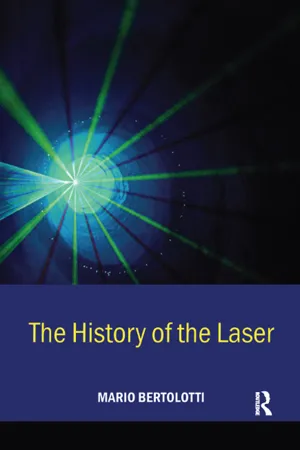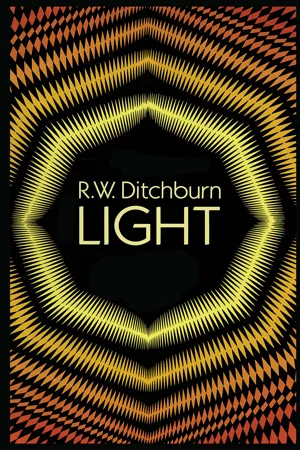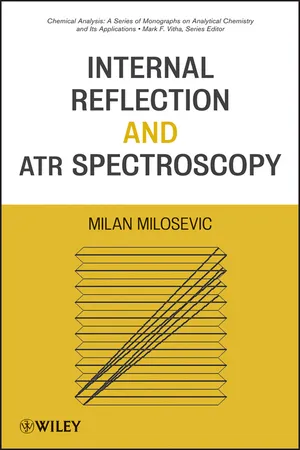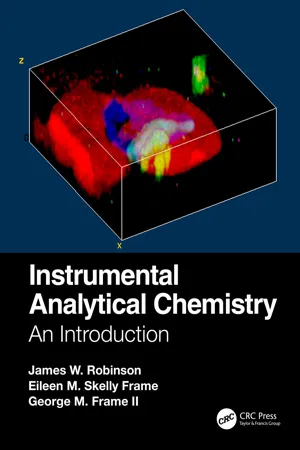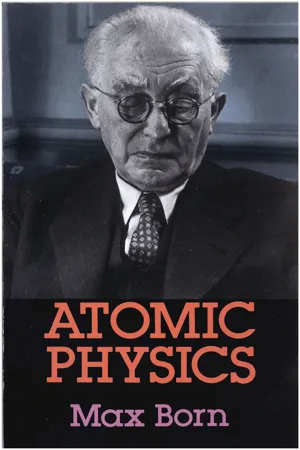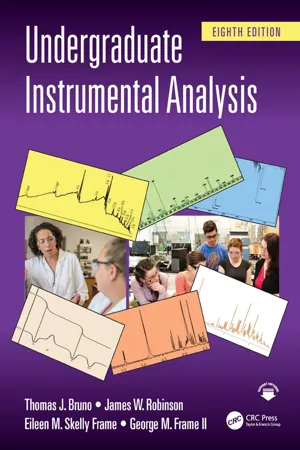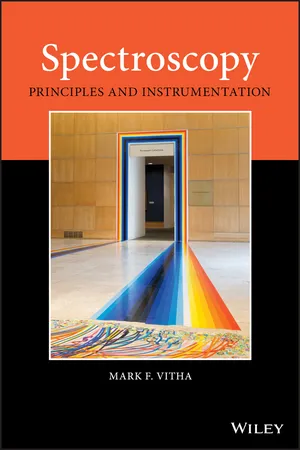Physics
Spectral Lines
Spectral lines are specific wavelengths of light emitted or absorbed by atoms or molecules. They are characteristic of the element or compound and can be used to identify its presence and properties. Spectral lines are produced when electrons in an atom move between energy levels, emitting or absorbing photons with specific energies corresponding to the line's wavelength.
Written by Perlego with AI-assistance
Related key terms
12 Key excerpts on "Spectral Lines"
- eBook - ePub
- Grant R. Fowles(Author)
- 2012(Publication Date)
- Dover Publications(Publisher)
line image of the slit is formed at the focal plane for each different wavelength comprising the radiation. Sources of line spectra include such things as arcs, sparks, and electric discharges through gases.The optical spectra of most atoms are quite complex and the line patterns are seemingly random in appearance. A few elements, notably hydrogen and the alkali metals, exhibit relatively simple spectra that are characterized by easily recognized series of lines converging toward a limit.The optical spectra of many molecules, particularly diatomic molecules, appear as more or less regularly spaced “bands” when examined with a spectroscopic instrument of low resolving power. However, under high resolution, these bands are found to be sequences of closely spaced lines.When white light is sent through an unexcited gas or vapor, it is generally found that the atoms or molecules comprising the vapor absorb just those same frequencies that they would emit if excited. The result is that those particular frequencies are either weakened or are entirely missing from the light that is transmitted through the vapor. This effect is present in ordinary sunlight, the spectrum of which appears as numerous dark lines on a bright continuous background.The dark lines are called Fraunhofer lines after J. Fraunhofer who made early quantitative measurements. These lines reveal the presence of a relatively cool layer of gas in the sun’s upper atmosphere. The atoms in this layer absorb their own characteristic wavelengths from the light coming from the hot, dense surface of the sun below, which emits thermal radiation corresponding to a temperature of about 5500°K.Selective absorption is also exhibited by solids. Virtually all transparent solids show broad absorption bands in the infrared and ultraviolet. ln most colored substances these absorption bands extend into the visible region. However, relatively sharp absorption bands may occur in certain cases such as crystals and glasses that contain rare earth atoms as impurities. - eBook - ePub
Fundamentals of Radio Astronomy
Astrophysics
- Ronald L. Snell, Stanley Kurtz, Jonathan Marr(Authors)
- 2019(Publication Date)
- CRC Press(Publisher)
Chapter 4Spectral LinesS pectral lines result from the interaction of light with atoms, ions and molecules. The development of quantum mechanics, describing the behavior of matter and its interaction with light on atomic scales, led to the realization that certain properties (such as angular momentum or energy) of an atom or molecule are restricted to a discrete or quantized set of values. Changes of an atom’s energy, for example, can only occur between these discrete sets of values. Light is also quantized into discrete particles of energy or photons, and unlike the processes we described in Chapter 3 , the interaction of light with electrons bound to atoms and molecules usually involves only a single photon. In the following discussion we assume the reader has some background in modern physics.Let us start our discussion by reviewing the electronic states of the hydrogen atom and its possible photon interactions. With regards to the electron’s orbitals, the allowed energy states of the hydrogen atom, labeled by their principal quantum number n, are given byE n= − 13.60 (1) eV ,n 2(4.1) where 1 eV (electron volt) = 1.60 × 10−12 ergs. The lowest energy state (or the ground state) is denoted by n = 1, while higher values of n indicate higher energy states, often referred to as excited states. Note that the total electronic energy (kinetic and electric potential energy) is negative, as one would expect if the electron is bound to the nucleus. Often the energies of the excited states are measured relative to the energy in the ground state. In this case the relative energy levels of hydrogen are given byE n= 13.60 ( 1 −1) eV .n 2A useful way to depict the allowed energy states of an atom or molecule is an energy level diagram that has energy on the vertical axis and the allowed energy states indicated as horizontal lines. The energy level diagram for the orbital energy of the electron in the hydrogen atom is shown in Figure 4.1 . Note that the electronic energy levels for hydrogen get closer and closer together as the principal quantum number grows larger. If the energy added to an electron in the ground state of the hydrogen atom exceeds 13.60 eV, then the electron will not be bound to the nucleus and the atom is said to be ionized. For this reason, 13.60 eV is called the ionization energy - eBook - ePub
- Kenneth W. Ford, Paul Hewitt(Authors)
- 2011(Publication Date)
- Harvard University Press(Publisher)
Fraunhofer lines. A “line” in a spectrum is an image of the spectroscope’s entrance slit at a particular frequency (or wavelength). For the dark lines observed by Fraunhofer, it shows the absence, or near absence, of light of that frequency. Scientists later discovered bright lines, or “emission lines,” in laboratory spectra on Earth showing enhanced radiation at particular frequencies.FIGURE19 Spectral Lines emitted by sources on Earth match absorption lines in sunlight.Some of the emission lines turned out to match precisely Fraunhofer’s dark lines. This and other evidence showed that a material can emit and absorb light at the same frequencies. Moreover, every element has its own particular “signature” of Spectral Lines.* In the midnineteenth century, this made spectral analysis a tool of chemical analysis. Today it makes it possible for astronomers to identify elements in distant galaxies or gas clouds. Fraunhofer’s lines provided some of the first evidence that the same elements exist in the cosmos as on Earth. These lines result from the absorption of sunlight at selected frequencies by cooler atoms hovering above the Sun’s surface. Interestingly, one element was discovered through one of its Spectral Lines in sunlight before it was identified on Earth. Observing sunlight during an eclipse in 1868, the British astronomer Norman Lockyer and the French scientist Pierre Janssen independently noticed a new spectral line, which Lockyer correctly attributed to a new element. Appropriately, he named it helium , after the Sun.* Figure 19 shows some emission spectra and the principal lines in the solar spectrum.Many of the greatest advances in science have come from uniting things that had been believed to be separate. Newton united motion on Earth with motion in the heavens. Einstein united space and time as well as mass and energy. Early in the nineteenth century, in a Danish classroom, Hans Christian Oersted had revealed the link between electricity and magnetism. Later in that century, the British physicist James Clerk Maxwell added another link, uniting light and electromagnetism. When electric charge oscillates or is accelerated, Maxwell argued, electromagnetic radiation is emitted. At certain frequencies—a few times 1014 - eBook - ePub
- Mario Bertolotti(Author)
- 2004(Publication Date)
- CRC Press(Publisher)
If, for example, we send an intense light containing all visible wavelengths (a continuum) through a flame in which sodium is burnt, the transmitted light is found to lack the wavelengths corresponding to the two yellow lines of the D-line of sodium. In the spectrum two dark lines appear at the place of the two bright lines that are observed in the emission spectrum. This explanation applies not only to our Sun but to every star. In fact, dark lines similar to the ones Fraunhofer observed in the solar spectrum are observed in the spectra of all stars, and their positions in the spectrum indicate which wavelengths have been absorbed by the substances present in the stellar atmospheres, so allowing us to identify them. Fundamental contributions to this new science of spectroscopy were made by Kirchhoff, David Brewster, John Herschel (1792–1871), William Henry Fox Talbot, Charles Wheatstone (1802–1875), Antoine-Philibert Masson (1806–1880), Anders Jonas Ångström (1814–1874) and William Swan. The fact that spectra of a substance are sometimes composed of a number of discrete lines and sometimes occur in the form of bands was finally explained by George Salet (1875)—after many controversies—by associating the line and band spectra to atoms and molecules respectively. Atoms Already Democritus and Leucippus in the 5th century BC had spoken of atoms. The Latin poet Lucretius (98–55 BC) in De rerum natura, explaining Democritus’ theory, said that air, water, earth and all the other things of this world are made by a number of particles or corpuscles—atoms—engaged in a restless, very rapid movement, and these are so small as to be perfectly invisible to the human eye - eBook - ePub
- Leo Graetz, G. Barr(Authors)
- 2014(Publication Date)
- Routledge(Publisher)
LECTURE V LINE SPECTRA AND BOHR’S MODEL OF THE ATOM P RIOR to the discovery of radio-activity, the most sensitive method available in chemistry for the detection of the smallest traces of substances was, as is well known, that of spectroscopic analysis; and it was by this method that the discovery of a large number of new elements was rendered possible. The principle of it is to cause the light emitted by incandescent vapours or by luminous gases to pass through a slit and a prism, whereby it is spread out into a spectrum. What then appears is not, as with white-hot solids, an extended band which contains all the colours from red to violet merging continuously into one another, i.e. a complete spectrum, but only a few or sometimes many distinct coloured lines; this is what is called a line spectrum. The lines which are produced under these conditions are so characteristic of the chemical elements that are present in the luminous vapour that it is possible to deduce, inversely, the presence of a particular element from the occurrence of certain lines. In the most accurate experiments a diffraction grating is used instead of a prism for the production and examination of the spectrum; the best gratings are those of Rowland, consisting of a plate of speculum metal on which are ruled 1700 fine equidistant lines per millimetre. If the light from a luminous vapour or gas is allowed to pass through a slit and fall on such a grating, diffraction spectra are obtained by reflection on both sides of the direct image of the slit; there are a primary, a secondary, and a tertiary spectrum at increasing angular distances from the direct image - eBook - ePub
- R. W. Ditchburn(Author)
- 2013(Publication Date)
- Dover Publications(Publisher)
CHAPTER IV
Representation of Light by Wave Trains of Finite Length
4.1. Sources of Light· Types of Spectra.The classification of sources of light is an important preliminary to the application of wave theory. From this point of view, the most significant classification is made by means of spectra. Modern instruments, developed from the simple apparatus by which Newton first discovered the dispersion of light, enable the spectra produced by different sources to be examined in detail. These instruments are called spectroscopes when they are designed for visual examination of the spectrum, and spectrographs when they are arranged so that it may be photographed. Using these instruments, three main types of spectra have been discovered. These are called line spectra, band spectra, and continuous spectra. Each type may be observed either as an emission spectrum or as an absorption spectrum. Plate I (p. 72) and Plate II (p. 126) include some typical spectra.4.2. Line Spectra and Continuous Spectra.An emission-line spectrum consists of a number of fairly narrow lines with dark regions between them (seePlate Ia,b,c). There may be only a few, or there may be several thousand lines. Narrow (or “sharp”) lines are produced when atoms are able to radiate light without being greatly affected by collisions with other atoms. Sharp lines are usually produced by an electrical discharge in gases at low pressure. Each line is characteristic of the kind of atom by which it is emitted. Sodium emits two lines fairly close together in the yellow region of the spectrum (Plate Ia); cadmium emits a strong red and a strong green line, as well as many weaker lines (Plate Ib); mercury emits several strong lines (Plate Ic). When an electrical discharge is produced in a gas at a pressure of a few atmospheres, the lines become less sharp (Plate Id - eBook - ePub
- Milan Milosevic(Author)
- 2012(Publication Date)
- Wiley(Publisher)
However, the abundance of information generated by spectroscopy was contrasted with the total lack of understanding of how the spectra themselves are generated. People knew that light is a wave phenomenon similar to sound. The sound generated by a taut string consists of a set of characteristic frequencies. A string with a different tension or of a different length produces a sound of a different frequency. This would make it plausible that different elements would produce different sets of light frequencies. Even the fact that a taut string could be resonantly excited into vibrations by a sound of the same frequency that it would sound if struck was seen analogous to why cold atoms would absorb the same frequencies of light that they would emit when heated.While not in itself surprising, the existence of these characteristic frequencies associated with different elements was totally stomping the scientists when they tried to understand them based on the available physical theories known collectively as classical physics. Soon, it became obvious that classical physics could not explain the observed spectra. A revolutionary new theory called quantum mechanics had to be developed to provide the explanation. The explanation, however perfect, came with an uneasy requirement to abandon common sense and to proceed into the unintuitive and forbidding world of quantum mechanics following mathematics where intuition fails.After first providing a spectacular confirmation that the universe is filled with the same atoms and compounds that we find here on Earth, spectroscopy provided another spectacular result. Measuring spectra of distant nebulae in the first half of the twentieth century, Hubble discovered that the Spectral Lines of elements and compounds from those distant nebulae are shifted from their terrestrial positions toward lower frequencies (referred to as redshift since red light is the visible light with the lowest frequency). This was a puzzling discovery.The explanation that was eventually accepted is that those distant nebulae recede from us in all directions with high speeds. The recession at high speeds shifts frequencies through what is known as Doppler effect. The effect is commonly observed when a whistling train passes by. The pitch of the whistle is higher while the train is approaching and it suddenly turns lower as the train passes by and starts moving away. - eBook - ePub
Instrumental Analytical Chemistry
An Introduction
- James W. Robinson, Eileen M. Skelly Frame, George M. Frame II(Authors)
- 2021(Publication Date)
- CRC Press(Publisher)
Note that a free gas phase atom has no rotational or vibrational energy associated with it. When an electron is promoted to a higher atomic excited state, the change in energy is very well defined and the wavelength absorbed (or emitted on relaxation to the ground state) can be considered monochromatic. The wavelengths of light involved in valence electronic transitions in atoms fall in the visible and ultraviolet regions of the spectrum. This region is often called the UV/VIS region for short. The energy level diagrams for all elements have been determined, and tables of wavelengths absorbed and emitted by atoms are available. Appendix 6.1 (book website) lists the absorption wavelengths used to measure elements by AAS (Chapter 6). Figure 2.6 Energy levels in mercury atoms (units of energy are electron volts, eV). Knowing what wavelengths of light are absorbed or emitted by a sample permits qualitative identification of the elements present in the sample. Measuring the intensity of light absorbed or emitted at a given wavelength provides quantitative elemental analysis. All of the atomic spectroscopy methods—absorption, fluorescence, and emission—are extremely sensitive. As little as 10 −12 –10 −15 g of an element may be detected using atomic spectroscopy. It is possible for atoms to absorb higher energy radiation, in the X-ray region; such absorption may result in the inner shell (core) electrons being promoted to an excited state, with the subsequent emission of X-ray radiation. This process forms the basis for qualitative and quantitative elemental analysis by XRF spectroscopy, as well as other X-ray techniques, discussed in Chapter 8. 2.3 Molecules and Molecular Spectroscopy The energy states associated with molecules, like those of atoms, are also quantized. There are very powerful spectroscopic methods for studying transitions between permitted states in molecules using radiation from the radio wave region to the UV region - eBook - ePub
- David M. Gates(Author)
- 2012(Publication Date)
- Dover Publications(Publisher)
ance throughout this book for all uses.The spectral characteristics of the earth’s atmosphere are described before the spectral distribution of sunlight since the atmosphere has a strong effect on the spectral distribution of sunlight received at the earth’s surface. The basic theory of molecular spectroscopy is given first in order that the absorptive and radiative properties of the earth’s atmosphere can be properly understood.Molecular Spectra
Atoms have absorption and emission spectra corresponding to discrete changes of the energy states of their electrons. The energy state of an electron bound in orbit around a nucleus is dependent upon the orbital number, angular momentum, and spin of the electron. As an electron moves from an inner to an outer orbit, energy is absorbed. In turn, when an electron jumps from an outer to an inner orbit, radiation is emitted by the atom. Higher energy states characteristic of outer electron orbits converge to smaller energy differences from orbit to orbit until ionization occurs and an energy continuum results. The line emissions or absorptions of such well-known spectral sequences as the Balmer, Lyman, Pas-chen, Brackett, and Pfund series of atomic hydrogen are manifestations of transitions between various orbital states and changes in spin and angular momentum.When atoms bind together to form molecules, additional energy states exist because of vibrational and rotational modes within the molecule. A simple diatomic molecule has only one vibrational mode, which is an oscillation of the atoms along the axis of the molecule. This vibrational oscillation modulates the electron energy states, and so the spectra produced are more complex than those of single atoms. The diatomic molecule can tumble or rotate as it is jostled about by collisions in a gas. This rotational motion is quantized and will further modulate the energy states of the electrons and add additional complexity to the absorption and emission spectra. Polyatomic molecules have much more complicated spectra than diatomic molecules. A large portion of the earth’s atmospheric absorption spectrum is caused by polyatomic molecules. - eBook - ePub
- Max Born(Author)
- 2013(Publication Date)
- Dover Publications(Publisher)
fig. 14 , Plate IX), whereas the latter, though of like structure for elements of like chemical character, are quite different for elements belonging to different columns of the periodic table. This means in the first place that X-ray spectra must have their source in the interior of the atom, whereas for optical spectra, just as for chemical behaviour, it is the outer region of atoms which matters.The lines found by experiment, which are denoted by Kα ,Kβ , . . ., Lα , Lβ , . . ., Mα , Mβ , . . ., can be arranged in a term scheme, by taking advantage of the difference relationswhich correspond to Ritz’s combination principle; these have been tested experimentally with great exactness, and found to be fulfilled as stated.The interpretation of X-ray spectra was given by Kossel (1917). In the atom the electrons are arranged in shells, there being a K shell, an L shell, &c. The electrons are most firmly bound in the K shell, less firmly in the L shell, still less firmly in the M shell, and so on. The energy levels indicated by horizontal lines in fig. 15 correspond to the electrons in the individual shells. The excitation of a k-line, according to Kossel, has to be pictured as follows. By some process (collision, absorption of light) an electron of the K shell is ejected from it. For this a definite minimum energy is requisite; all amounts of energy, which are greater than this least amount, can be absorbed. In absorption, we therefore find in the spectrum a sharp edge, the absorption edge; wave-lengths shorter than this are absorbed. Absorption lines, such as occur in the visible region, are not found in the X-ray region.Fig. 15.—Term scheme of X-ray levels (after Kossel), with the transitions corresponding to the X-ray lines. - eBook - ePub
- Thomas J. Bruno, James W. Robinson, George M. Frame II, Eileen M. Skelly Frame(Authors)
- 2023(Publication Date)
- CRC Press(Publisher)
The design of the radiation source varies with the wavelength range for which it is used (e.g., IR, UV, visible), and details of specific sources will be discussed in the appropriate instrumentation chapter. Most sources will have their intensities change exponentially with changes in voltage, so in all cases, a reliable, steady power supply to the radiation source is required. Voltage regulators (also called line conditioners) are available to compensate for variations in incoming voltage. A doublebeam optical configuration may also be used to compensate for variations in source stability, as described in Section 3.6.5.There are two major types of radiation sources used in analytical spectroscopy: continuum sources and line sources. Continuum sources emit radiation over a wide range of wavelengths, and the intensity of emission varies slowly as a function of wavelength. Typical continuum sources include the tungsten filament lamp that produces visible radiation (white light) and high-pressure xenon arc lamps, the deuterium lamp for the UV region, high-pressure mercury or xenon arc lamps for the UV region, and heated solid ceramics or heated wires for the IR region of the spectrum. Continuum sources are used for most molecular absorption and fluorescence spectrometric instruments. Line sources, in contrast, emit only a few discrete wavelengths of light, and the intensity is a strong function of the wavelength. Typical line sources include hollow cathode lamps and electrodeless discharge lamps, used in the UV and visible regions for AAS and atomic fluorescence spectrometry, sodium or mercury vapor lamps (similar to the lamps now used in streetlamps) for lines in the UV and visible regions, and lasers. Lasers are high-intensity coherent line sources; lasers are available with emission lines in the UV, visible, and IR regions. They are used as sources in Raman spectroscopy and molecular and atomic fluorescence spectroscopies.3.6.2 Wavelength Selection Devices
3.6.2.1 Filters
The simplest and most inexpensive way to select certain portions of the electromagnetic spectrum is with a filter. There are two major types, absorption filters and interference filters. Absorption filters can be as simple as a piece of colored glass. In Section 3.1, we discussed how blue glass transmits blue wavelengths of the visible spectrum but absorbs red and yellow wavelengths. This is an example of an absorption filter for isolating the blue region of the visible spectrum. Colored glass absorption filters can be purchased that isolate various ranges of visible light. These filters are stable, simple, and cheap, so they are excellent for use in portable spectrometers designed to be carried into the field. The biggest limitation is that the range of wavelengths transmitted is broad compared with prisms and gratings that are also devices used to select a narrow wavelength range from a broadband polychromatic source. The transmission range may be 50–300 nm for typical absorption filters. Absorption filters are limited to the visible region of the spectrum and the X-ray region. - eBook - ePub
Spectroscopy
Principles and Instrumentation
- Mark F. Vitha(Author)
- 2018(Publication Date)
- Wiley(Publisher)
1 FUNDAMENTALS OF SPECTROSCOPYAll instruments are designed to take advantage of some molecular property or behavior. For example, chromatography is based on the different strength of intermolecular interactions that molecules have with mobile and stationary phases. Electrochemistry is based on the ability of molecules to gain or lose electrons. In this book, we focus on the fact that atoms and molecules absorb and emit electromagnetic radiation (EMR). By measuring the amount and the characteristics of the EMR absorbed and emitted, we can measure the concentration of particular molecules present in a sample or gain structural information about them. You may already be familiar with several of the instrumental methods used to measure the absorption and emission of electromagnetic radiation, such as UV‐visible, infrared (IR), and fluorescence spectroscopy.In order to better understand the fundamental basis of these techniques, in this chapter we examine the properties of electromagnetic radiation and its effects on atoms and molecules. In subsequent chapters, we examine specific spectroscopic techniques. While all the techniques share common features, the specific instruments required and the information we gain from each are quite different and therefore require individual examination.1.1. PROPERTIES OF ELECTROMAGNETIC RADIATION
Spectroscopic methods ultimately rely on measuring characteristics of electromagnetic radiation, which travels through space as a wave, as shown in Figure 1.1 . As the name implies, it has two components, an electric field and a magnetic field, which are at right angles to one another. Figure 1.1 shows only a single wave with its electric field oriented along the x‐axis, but in reality, most sources of electromagnetic radiation, like light bulbs and car headlights, emit radiation in which the electric field of the waves are randomly distributed around the x
Index pages curate the most relevant extracts from our library of academic textbooks. They’ve been created using an in-house natural language model (NLM), each adding context and meaning to key research topics.



